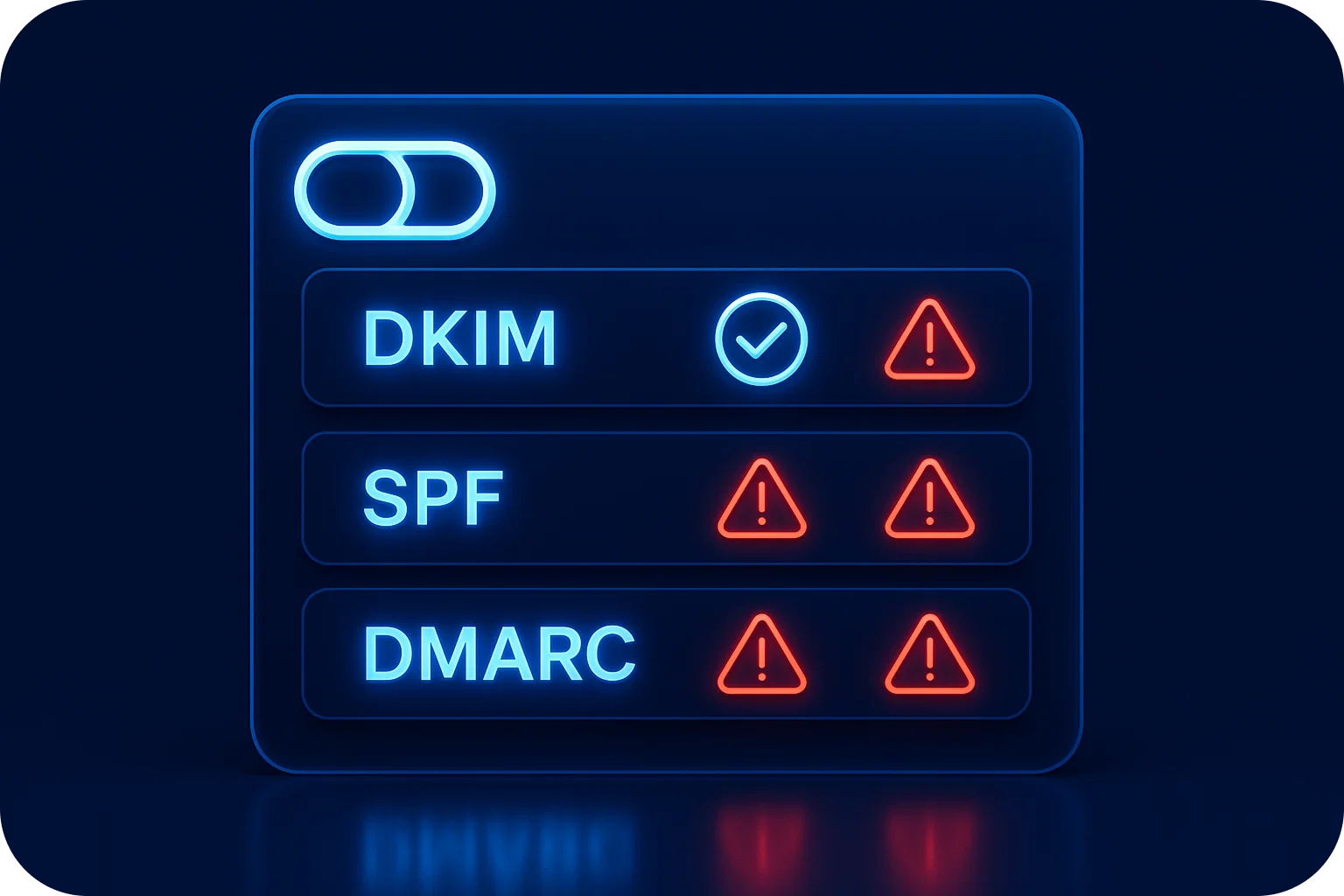The $50,000 Mistake: What Happens When Your Email Infrastructure Fails
.png)
Email infrastructure failures cost businesses an average of $50,000 in lost revenue and recovery expenses within the first 8 weeks. This figure represents immediate lost sales, sender reputation damage, opportunity costs, and team productivity losses that compound rapidly when deliverability drops.
Understanding these costs and implementing preventive measures is critical for any business relying on email outreach for revenue generation.
The Hidden Costs of Email Infrastructure Failure
When your email infrastructure fails, the financial impact extends across multiple business areas. Here's the complete breakdown:
1. Immediate Revenue Loss
For a typical startup with 5 sales reps sending 100 emails daily:
- Monthly email volume: 15,000 emails
- Average response rate: 10-15%
- Conversion rate: 5-8%
- Average deal size: $5,000
When cold email deliverability drops from 98% to 20% (common with infrastructure failures), monthly revenue loss ranges from $15,000-$30,000. Over a quarter, this compounds to the $50,000 threshold.
2. Sender Reputation Damage
Your sender reputation functions as a credit score for email delivery. Recovery from reputation damage requires:
- New domain purchases: $500-$1,000
- Email warm-up services: $2,000-$5,000/month
- Lost productivity during recovery: $15,000-$30,000
- Consultant fees for reputation repair: $5,000-$10,000
3. Opportunity Cost
During infrastructure recovery periods, competitors capture prospects that would otherwise convert. These missed opportunities rarely return, as prospects move forward with alternative solutions.
4. Team Productivity Loss
Sales teams redirect focus from selling to troubleshooting. Customer success communications fail to deliver. The productivity impact affects all revenue-generating activities.
Root Causes of Email Infrastructure Failure
Infrastructure failures stem from predictable technical and operational issues:
Poor DNS Configuration
Incorrect SPF, DKIM, and DMARC records cause email providers to reject or spam-filter messages. These authentication protocols are essential for establishing sender legitimacy.
Inadequate Warm-up Processes
Launching cold email campaigns without proper warm-up triggers can trigger spam filters. Email providers flag sudden volume increases as suspicious activity, damaging sender reputation immediately.
Single Point of Failure
Relying on one domain or email provider creates vulnerability. When that single point fails, entire outreach operations cease functioning.
Lack of Deliverability Monitoring
Most businesses discover problems only after response rates crash. By this point, sender reputation damage is extensive and costly to repair.
The 8-Week Cost Accumulation Timeline
Infrastructure failure costs accumulate predictably over time:
Week 1: Initial Impact
- Deliverability drops to 30%
- Response rates fall 70%
- Lost revenue: $3,500
- Problem recognition begins
Week 2: Problem Escalation
- Deliverability hits 15%
- Emergency troubleshooting initiated
- Lost revenue: $7,000
- Productivity drops 40%
Week 3: Damage Control Phase
- Domain reputation severely compromised
- New domains purchased and warm-up initiated
- Lost revenue: $10,500
- Recovery costs begin: $2,000
Week 4: Recovery Attempts
- Partial functionality restored
- Deliverability at 60% of original capacity
- Lost revenue: $14,000
- Additional recovery costs: $3,000
Weeks 5-8: Rebuilding Period
- Gradual improvement to 85% deliverability
- Lost revenue: $21,000
- Total recovery investment: $8,000
Total 8-week impact: $50,000+ in lost revenue and recovery costs
Prevention Strategies for Email Infrastructure
Infrastructure failures are preventable with proper email infrastructure planning:
1. Implement Redundancy Systems
Distribute risk across multiple domains and email providers. Best practice: 3-5 domains per major campaign, with 3-5 email accounts per domain. This ensures continued operation if individual components fail.
2. Perfect DNS Configuration
Proper SPF, DKIM, and DMARC setup is mandatory. These authentication protocols verify message legitimacy to email providers, preventing automatic rejection or spam filtering.
3. Systematic Warm-up Processes
Begin with 5-10 emails per day per account, gradually increasing over 3-4 weeks. This builds a positive sender reputation before launching full-scale campaigns.
4. Continuous Monitoring Systems
Track deliverability metrics daily. Early detection allows for problem resolution before major reputation damage occurs.
5. Professional Infrastructure Management
Partner with specialists who understand email deliverability complexities. Professional management costs significantly less than recovery expenses.
ROI Analysis of Proper Email Infrastructure
Investing in robust email infrastructure delivers measurable returns:
- 98% deliverability rates vs. 60-70% with DIY approaches
- 10-minute implementation vs. weeks of internal setup
- Scalable to 100x volume without proportional cost increases
- Enterprise-grade security protecting reputation assets
For a startup sending 15,000 emails monthly, the difference between 70% and 98% deliverability equals $8,400 in additional monthly revenue, $100,800 annually.
Infrastructure Performance Benchmarks
Professional email infrastructure delivers superior performance metrics:
Deliverability Rates
- Professional infrastructure: 96%-98%
- DIY approaches: 60%-75%
- Failed infrastructure: 15%-30%
Implementation Timeframes
- Professional setup: 10 minutes
- Internal setup: 2-4 weeks
- Recovery from failure: 6-12 weeks
Warm-up Requirements
- Optimal warm-up period: 3-4 weeks
- Maximum daily volume during warm-up: 20 emails/inbox
- Maximum production volume: 100 emails/inbox/day
- Recommended production volume: 20 emails/inbox/day
Risk Assessment Framework
Evaluate your current email infrastructure risk level:
High Risk Indicators
- Single domain dependency
- Inconsistent DNS configuration
- No deliverability monitoring
- DIY infrastructure management
- Recent deliverability drops
Medium Risk Indicators
- Limited domain redundancy (2-3 domains)
- Basic monitoring in place
- Occasional deliverability issues
- Manual warm-up processes
Low Risk Indicators
- Multiple domain redundancy (5+ domains)
- Professional infrastructure management
- Continuous deliverability monitoring
- Automated warm-up systems
- 98%+ deliverability rates
Implementation Action Plan
Immediate steps to prevent infrastructure failure:
Week 1: Assessment
- Audit the current DNS configuration
- Evaluate domain redundancy
- Review deliverability metrics
- Assess monitoring capabilities
Week 2: Planning
- Design redundancy architecture
- Select a professional infrastructure provider
- Plan migration timeline
- Establish monitoring protocols
Week 3-4: Implementation
- Deploy new infrastructure
- Configure DNS records
- Initiate warm-up processes
- Implement monitoring systems
Cost-Benefit Analysis
Professional email infrastructure investment vs. failure costs:
Professional Infrastructure Investment
- Monthly infrastructure cost: $500-$2,000
- Setup and configuration: $0-$500
- Annual total: $6,000-$24,500
Infrastructure Failure Costs
- 8-week revenue loss: $35,000-$50,000
- Recovery expenses: $8,000-$15,000
- Opportunity costs: $10,000-$25,000
- Total failure cost: $53,000-$90,000
ROI of prevention: 200%-1,400% in first failure avoidance alone
Conclusion
Email infrastructure failure represents a preventable business risk with quantifiable costs. The $50,000 mistake occurs when businesses underestimate the importance of professional infrastructure management.
Key prevention factors include:
- Multi-domain redundancy systems
- Professional DNS configuration
- Systematic warm-up processes
- Continuous deliverability monitoring
- Expert infrastructure management
The cost of prevention is a fraction of recovery expenses. More importantly, proper infrastructure transforms email from a risk factor into a reliable revenue engine.
Your sender reputation and revenue streams are too valuable to risk with inadequate infrastructure. Professional email infrastructure management provides insurance against failure while maximizing deliverability performance.
Audit your current email infrastructure today. If you identify high-risk indicators, take immediate action to prevent becoming another $50,000 mistake statistic.
More articles
Get started now




%201.png)





